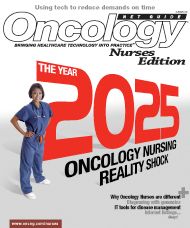5 Questions... with Pamela Cipriano, PhD, RN, FAAN
As the demands on nurses across all specialties increase—and as the nursing shortage worsens—some in the nursing community are working at the problem from a new angle.
1 What were your goals when you began the TD2 research?
As the demands on nurses across all specialties increase—and as the nursing shortage worsens—some in the nursing community are working at the problem from a new angle. Rather than looking at how to increase the supply of nurses, Pamela Cipriano and colleagues are studying technology applications that can reduce the demands on a nurse’s time. Her ambitious project, sponsored by the Robert Wood Johnson Foundation, is called Technology Drill-Down, or TD2, and it has revealed some interesting insights into how nurses work with—and all too often, around—technology.
The overarching goal of TD2 is to determine how technology can reduce demands on nurses’ time. Are there actions that can be eliminated from the work of the registered nurse, or at least reduced, in order to preserve that nurse’s time so that she or he can have more time with patients? We looked around and saw a lot of initiatives to increase the supply of nurses, but we didn’t see much that focused on reducing the demands on the nurse’s time. We believed technology was the direction to go.
2 One of the problems with deploying technology solutions, though, is that if implemented poorly, nurses tend to work around them. How does TD2 address this problem?
With any new device that comes into the hospital, there’s usually pretty extensive training. Vendors will usually provide ongoing, on-site training. It’s easy to watch that skilled representative show you all the things the device can do, but when the nurses are left on their own, they may not remember everything. Because of the tremendous demand on nurses’ time, you try to limit the training to cover just the essentials. Sometimes, we don’t recognize when we’ve underutilized a technology, or if we’ve put something in that has a functionality nurses don’t like, how far they’ll go to get around it. For example, with medication cabinets, there are many steps involved [in dispensing medication], but there are also ways you can override the machine. You have to audit how often that machine gets overridden to know whether you have a problem. Some organizations aren’t very good at looking for underutilization or misuse of technology.
3 How can administrators improve their abilities to judge the success of an implementation?
They need to recognize an undertraining issue at the front end, and then measure more carefully the use of the technologies. Also, when assessing the technology, think about how it will affect nurses in terms of speed. Every solution you implement has to be fast. I think that’s the number one reason nurses won’t use new technologies as they were intended—it slows them down. It has to be intuitive, user-friendly, and fast.
4 If you gave nurses a choice of implementing a new technology or adding another nurse, would many rather just add another nurse?
You have to make a compelling argument that the technology will reduce their workload. If we can enhance the exchange of information between caregivers, that’s important, too. Nurses are aware of the pending nursing shortage. They know they’re never going to have as many people on staff as they think they should, so finding technologies that will substitute appropriately for individuals, they see that as a real advantage. We have to encourage, and sometimes force, nurses to use that equipment. They sometimes forget that they have it.
5 What are the next steps to get to specific recommendations based on your research?
We need to partner with our informatics expert panel, which is poised to take our results and incorporate them. We have a responsibility to bring our message to industry, where devices and systems are being introduced, to look at potential partnerships and work with a variety of vendors. It doesn’t help anyone for vendors to bring devices to the market that create more problems in the marketplace. We also want to work with policymakers to develop standards and address interoperability. Our niche, if you will, is to bring the information forward and to hand off to informatics experts and industry, and then continue to work on the policy side. If we can work with organizations like the American Organization of Nurse Executives, we can make sure that large purchasers of health IT can infl uence decisions at the local level, so that nobody is buying systems that haven’t been nurse-tested.
